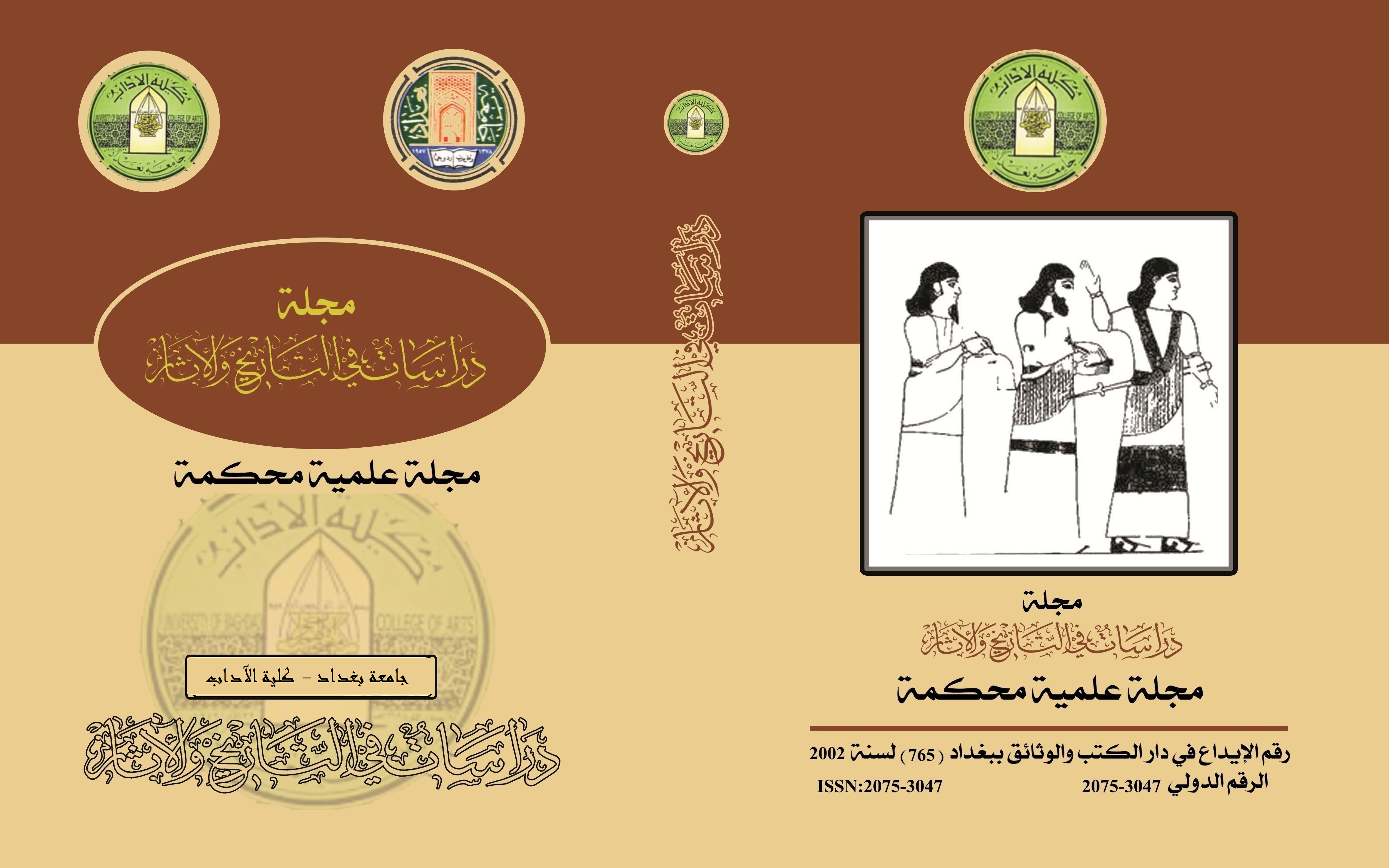الآلات الزراعية في المشاهد الفنية
الكلمات المفتاحية:
الآت الزراعية، المشاهد الفنية، الزراعة، القرىالملخص
استعملت الآلات الزراعية منذُ بداية الاستيطان منذُ ان بدأ الانسان يتفاعل مع البيئة ويستغلها لتتلائم مع حياته فبدأ فصنع آلاته وأدواته من مختلف المواد المتوفرة في بيئته الطبيعية. ولها أهمية كبيرة في حياته فهو يعمل جاهداً لصناعتها من أجل خدمته وتتفاوت في أهميتها فهناك أنواع منها استعملت في قطع الأشجار كالمنشار والأخرى وفي حرث الارض كالمحراث وبذر البذور كالمذراة.
ولم يتم العثور على مشاهد فنية تخص بعض الآلات والأدوات التي استعملت في الاعمال الزراعية كالفأس مثلاً والمجرفة والمنجل وغيرها لكن في الوقت نفسه جاءت إلينا هذه النماذج على شكل لقى أثرية ومن مواقع عديدة لبلاد الرافدين ومن ضمن الكتابات المسمارية.
المراجع
ابراهيم، هالة كريم، (2014). المواضيع الدينية في الاختام الاسطوانية من عصر الوركاء الى نهاية العصر السومري الحديث، رسالة ماجستير غير منشورة، جامعة بغداد، كلية الاداب، قسم الاثار، بغداد.
الاحمد، سامي سعيد، (1985). "الزراعة والري"،حضارة العراق،ج2، بغداد.
احمد، سهيلة مجيد، (1992). صناعة الاغذية في العصور العراقية القديمة، رسالة ماجستير منشورة، جامعة الموصل، كلية الاداب، قسم التاريخ، الموصل.
اسماعيل، خالد سالم و حسين، هيثم احمد ،(2010). "فؤول الزراعة والاشجار والنباتات وفؤول القنوات والابار في العصر البابلي(القديم والوسيط والحديث)،مجلة سُر من رأى،مج6،العدد31، الموصل.
البدراوي،عدنان مكي، (1985). "نشأة القرى العراقية الأولى بين الاستيطان الأول وحتى العصر الحجري الحديث"،حضارة العراق،ج3،بغداد.
بوتس، دانيال تي،(2006). حضارة وادي الرافدين الاسس المادية، ت:كاظم سعد الدين، بغداد.
حمودي، حسن مهدي، (2021). "تطور صناعة المنجل في العراق القديم خلال العصر الحجري الوسيط حتى نهاية العصر الحجري المعدني"،مجلة اثار الرافدين،ج2،مج6، الموصل.
الحيالي، فيحاء مولود، (2016). "الالهة والمشاهد الزراعية في فنون بلاد الرافدين"،مجلة الاداب،عدد118، بغداد.
الدباغ، تقي (2000). "اصول الزراعة والرعي"، مجلة سبأ، العدد9، عدن.
الدليمي، كريم عزيز حسن، (1996). الزراعة في العراق القديم منذ عصر فجر السلالات حتى نهاية العصر البابلي القديم3000-1595 ق. م.، رسالة ماجستير غير منشورة، جامعة بغداد، كلية الاداب، قسم الاثار، بغداد.
رشيد، صبحي انور و الحوري، (1982). حياة عبد علي، الاختام الاكدية في المتحف العراقي، بغداد.
سليمان، عامر(1993). العراق في التاريخ موجز التاريخ الحضاري، ج2، الموصل.
سليمان، عامر، (1988). "النظم المالية والاقتصادية"، موسوعة العراق في موكب الحضارة،ج1، بغداد .
طاهر، براق عبد الحسن، (2017). الملابس في اختام بلاد الرافدين في الالف الثالث قبل الميلاد دراسة اثارية فنية، رسالة ماجستير غير منشورة، جامعة بغداد، كلية الاداب، قسم الاثار، بغداد.
العاني، عماد طارق توفيق، (1986). الصناعات الحجرية حتى نهاية العصر الحجري الحديث، رسالة ماجستير غير منشورة، جامعة بغداد، كلية الآداب، قسم الاثار، بغداد.
القره غولي، زينة كريم عبد الله، (2020). مشاهد من الحياة اليومية في بلاد الرافدين في ضوء الواح فخارية غير منشورة من المتحف العراقي،رسالة ماجستير غير منشورة، جامعة بغداد، كلية الآداب، قسم الاثار، بغداد.
كسار، اكرم محمد عبد، (1987-1988). "مظاهر الحياة الاجتماعية والاقتصادية في العراق القديم منذ اواخر الالف السادس ق.م.حتى بداية النصف الثاني من الالف الخامس ق.م."، مجلة سومر،مج45،ج1-2، بغداد.
النجم، حسين يوسف، (2006). اقتصاد القرى الزراعية في العصرين الحجري الحديث والمعدني في العراق، اطروحة دكتوراه غير منشورة، جامعة الموصل، كلية الآداب، قسم التاريخ، الموصل.
ثانياً: المصادر الاجنبية
Amiet,P.(1961). La Glyptique Mesopotamienne Archique, Paris.
Furlong,I.,(1987). Divine Headdresses of Mesopotamia in the Early Dynastic Period, London.
Heinrich,E., (1936). Kleinfunde Aus Den Archaischen Tempelschichten in Uruk, Berlin.
Ward,W.H.,(1910). The Seal Cylinders Western Asia, Washington.
التنزيلات
منشور
إصدار
القسم
الرخصة

هذا العمل مرخص بموجب Creative Commons Attribution 4.0 International License.
:حقوق الطبع والنشر والترخيص
بالنسبة لجميع البحوث المنشورة في مجلة دراسات في التاريخ والآثار، يحتفظ الباحثون بحقوق النشر. يتم ترخيص البحوث بموجب ترخيص Creative Commons CC BY 4.0 المفتوح ، مما يعني أنه يجوز لأي شخص تنزيل البحث وقراءته مجانًا. بالإضافة إلى ذلك ، يجوز إعادة استخدام البحث واقتباسه شريطة أن يتم الاستشهاد المصدر المنشور الأصلي. تتيح هذه الشروط الاستخدام الأقصى لعمل الباحث وعرضه.
:إعادة إنتاج البحوث المنشورة من الناشرين الآخرين
من الضروري للغاية أن يحصل الباحثون على إذن لإعادة إنتاج أي بحث منشورة (أشكال أو مخططات أو جداول أو أي مقتطفات من نص) لا يدخل في نطاق الملكية العامة أو لا يملكون حقوق نشرها. يجب أن يطلب الباحثون إذنًا من مؤلف حقوق النشر (عادة ما يكون الناشر).
يطلب الإذن في الحالات التالية:
بحوثك الخاصة المنشورة من قِبل ناشرين آخرين ولم تحتفظ بحقوق النشر الخاصة بها.
مقتطفات كبيرة من بحوث أي شخص أو سلسلة من البحوث المنشورة.
استخدم الجداول والرسوم البيانية والمخططات والمخططات والأعمال الفنية إذا لم يتم التعديل عليها.
الصور الفوتوغرافية التي لا تملك حقوق لنشرها.
لا يطلب الإذن في الحالات التالية:
إعادة بناء الجدول الخاص بك مع البيانات المنشورة بالفعل في مكان آخر. يرجى ملاحظة أنه في هذه الحالة يجب عليك ذكر مصدر البيانات في شكل "بيانات من ..." أو "مقتبس من ...".
تعتبر عروض الأسعار القصيرة معقولة الاستخدام العادل ، وبالتالي لا تتطلب إذنًا.
الرسوم البيانية ، الرسوم البيانية ، المخططات ، الأعمال الفنية التي أعاد الباحث رسمها بالكامل والتي تم تغييرها بشكل ملحوظ إلى درجة لا تتطلب الاعتراف.
الحصول على إذن
لتجنب التأخير غير الضروري في عملية النشر ، يجب أن تبدأ في الحصول على أذونات في أقرب وقت ممكن. لا يمكن لمجلة الآداب نشر بحث مقتبس من منشورات أخرى دون إذن.
قد يمنحك مالك حقوق الطبع والنشر تعليمات بشأن شكل الإقرار الواجب اتباعه لتوثيق عمله ؛ بخلاف ذلك ، اتبع النمط: "مستنسخ بإذن من [المؤلف] ، [كتاب / المجلة] ؛ نشره [الناشر] ، [السنة]." في نهاية شرح الجدول ، الشكل أو المخطط.



















